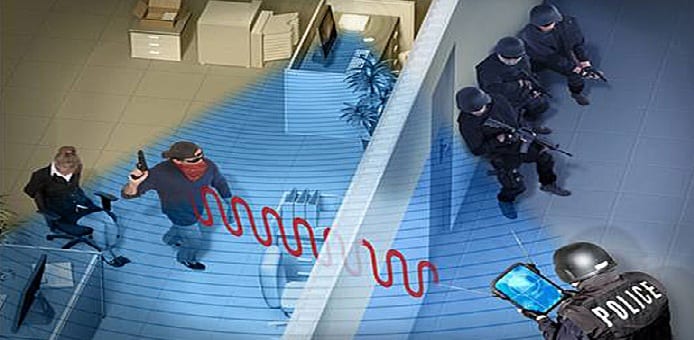Wi-Vi technology helps a person to “see through walls” using the Wi-Fi signals
Catching hold of criminals hiding behind walls has been made easy by the passive radar which can read the Doppler shifts in ambient radio signals which are emitted by Wi-Fi or mobile communications towers.
Gone are the days when criminals could easily shoot out the lights and try hiding in dark when congregated by police authorities. Already the creation of night vision goggles was helping the army and police authorities to catch hold of the criminals and now the hooligans have to worry about one more creation by the researchers and that is the passive radars which can catch hold of them on the basis of soft radio glow of wireless routers or mobile communication towers.
Table Of Contents
Tracking WiFi Signals to Passively See Through Walls Using NI USRP and LabVIEW:
Researchers at the University College London (UCL) have designed a novel technology which can track the Doppler shifts of the ubiquitous Wi-Fi and smartphone signals, thus helping authorities to “see” people who are moving even behind walls that are 25 centimeters in thickness.
Researchers believe that this novel technology can be used to detect the indoor moving targets for security purposes such as hostage situations. Apart from using it in public defenses the technology also finds it application in various scenarios such as crowd and traffic monitoring and human-machine interfacing.
At the National Instruments’ NI Week 2015 conference held in Austin, Texas from 3-9 August, this innovative technology has won the Engineering Impact Award under the category of RF and Communications.
In case of the UCL technology, it uses only passive radiation which it receives from the Wi-Fi routers hence it is much more reliable and cannot betray the surveillance. Different kinds of wireless signals are applied under different scenarios, for instance, by acquiring IEEE 802.11x (b, g, n, ac) signals this technology can help to track the indoor moving objects for security purposes as in case of hostage situations. On the contrary, the same system can also help to monitor cellular signals, such as Global System for Mobile Communications (GSM) or Long-Term Evolution (LTE) and this can help in determining the direction as well as the velocity of moving vehicles.
For calculating the position of the hidden target, the UCL system would compare the two signals:
- A reference channel : This receives the baseline signal from the Wi-Fi access point or from other RF source.
- A surveillance channel: This is the one which picks up the Doppler shifted waves that gets reflected from a moving human.
UCL technology works more or less like the traditional radar systems and it does rely on detecting the Doppler shifts in radio waves which are reflected by the moving objects. However, in case of traditional radar systems they transmit the radio waves whereas in the UCL technology the passive system relies on the ubiquitous Wi-Fi signals which are already present in the surrounding air waves. Due to the passive system, there is complete lack of spectrum occupation and power emission and this makes the UCL technology far better because the radar is undetectable.
Wi-Vi: See through Walls with W-Fi Signals:
Another group of researchers, Dina Katabi and Fadel Adib of MIT have developed a technology (Wi-Vi) which helps a person to “see through walls” using the Wi-Fi signals.
Basically, Wi-Vi captures the signals emitted by a person moving behind walls and in closed room. The Wi-Vi device comprises of active radars which are built through the wall and it can transmit as well as receive the signals.
Indoor target tracking using high doppler resolution passive Wi-Fi radar:
Another study comprises of a group of engineers who have published their papers which describes two Doppler only indoor passive Wi-Fi tracking methods based on “high Doppler resolution passive Wi-Fi radar”. Extended Kalman filter and the Sequential Importance Resampling (SIR) particle filters are the two filters which engineers have used in their study. This system basically works by comparing the reference and surveillance signals and it interprets even a very small frequency shifts and thus reveals the location and motion of hidden subjects.
Tan and his team, used a software defined passive Wi-Fi radar using a standard 802.11 access point as an illuminator to present the experimental results for these two tracking filters. Based on the experiment, the engineers concluded that of the two filters, SIR particle filter is the one which should be used for indoor tracking on the basis of Wi-Fi signals as it gives a much accurate and better performance. In their paper, the engineers have also given suggestions for simplifying the SIR particle and discussed various applications to multiple target tracking.
The engineers tweaked the processing parameters such as increasing the signal integration time and lowering the sensitivity thresholds; ultimately the engineers were able to make the passive radar “see through” the subtle movements which included even the hand gestures. The device was able to give some radar-style scatter plot along with some varied signals.
The entire details of the system was published in a paper which Tan and UCL colleagues Qingchao Chen, Karl Woodbridge, and Kevin Chetty presented at the 2015 IEEE International Conference on Acoustics, Speech and Signal Processing (ICASSP), held 19-24 April in South Brisbane, Australia.

